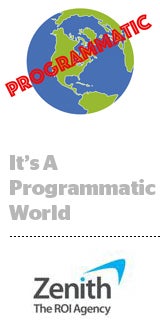Programmatic trading is coming to traditional channels such as TV, radio and OOH sooner than you might think, according to according to Zenith’s third Programmatic Marketing Forecast, released Monday.
Zenith predicts programmatic buying techniques used widely in digital display increasingly will bleed into more traditional media channels.
The Publicis-owned agency reckons that advertisers will spend around $5.6 billion programmatically across TV, radio, cinema and out-of-home this year, which represents around 6% of total ad spend in these areas.
The “desire is there,” although the availability of data to make these channels addressable is holding the industry back, said Jonathan Barnard, head of forecasting and director of global intelligence at Zenith.
“You need to be able to address ads to the level of the user for radio, at the household level for TV and at the location level for out-of-home,” he said. “The process will be faster or slower depending on the media. It will be a fair few years before programmatic TV becomes mainstream, but we’ll see more and more programmatic-like deals delivered to digital out-of-home displays.”
Meanwhile, global digital display media continues to grow at its usual brisk clip. By 2019, 67% of global digital display media will be bought and sold programmatically, up from 59% this year.
Some markets are more programmatically mature than others, but every market “is pretty much on the same path,” Barnard said.
English-speaking markets take the lead in terms of programmatic spend. In Canada, 81% of digital display was bought programmatically this year. In the US, programmatic digital spend clocked in at 78% and in the UK at 77%.
The US programmatic market, the largest by far, was valued at roughly $32.6 billion in 2017 – 57% of the global total.
China, however, is a programmatic laggard. The programmatic market in China is worth an estimated $5.3 billion, but only 29% of digital display advertising is being traded programmatically.
Barnard attributes the lack of programmatic spend in China to the “difference in its current advertising and marketing culture.”
While personalized and data-driven advertising is burgeoning in the US, UK and Canada, Chinese advertisers are more focused on mobile ecommerce and online video, although that will likely change as internet giants like Tencent start pushing into ad tech and targeted advertising.
The main takeaway is that advertisers are spending more on programmatic and that trend is only accelerating. Even the General Data Protection Regulation, Europe’s wide-ranging privacy legislation coming into force in May, won’t have much of a chilling effect on the growth of programmatic spend, Barnard said.
“GDPR might affect the type of data around which programmatic can be traded,” he said, “but I don’t see it impacting the use of programmatic technology.”















